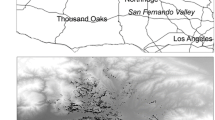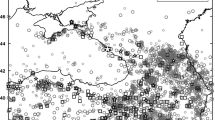Abstract
Microzonation is an effort to evaluate and map potential hazards found in an area, urban area in particular, that could be induced by strong ground shaking during an earthquake. These hazards include: ground motion amplification, liquefaction, and slope failure. The microzonation maps, depicting ground-motion amplification, liquefaction, and landslide potentials, can be produced if the ground motion on bedrock (input) and the site conditions are known. These maps, in combination with ground-motion hazard maps (on bedrock), can be used to develop a variety of hazard mitigation strategies such as seismic risk assessment, emergency response and preparedness, and land-use planning. However, these maps have certain limitations that result from the nature of regional mapping, data limitations, generalization, and computer modeling. These microzonations show that when strong ground shaking occurs, damage is more likely to occur, or be more severe, in the higher hazard areas. The zones shown on the hazard maps should not serve as a substitute for site-specific evaluations.
Similar content being viewed by others
References
Anderson G A and Brune J N 1999 Probabilistic seismic hazard analysis without the ergodic assumption; Seism. Res. Lett. 70 19–28.
Andrus R D and Stokoe K H 1997 Liquefaction resistance based on shear wave velocity: Report to the NCEER Workshop on Evaluation of Liquefaction Resistance (9/18/97 version), Jan. 4–5, Salt Lake City, Utah.
Andrus R D, Stokoe K H and Chung R M 1999 Draft guidelines for evaluating liquefaction resistance using shear-wave velocity measurements and simplified procedures; National Institute of Standards and Technology, NISTIR 6277, 121p.
Atkinson G M and Boore D M 2006 Earthquake groundmotion predictions for eastern North America; Bull. Seismol. Soc. Am. 96 2181–2205.
Bauer R A, Kiefer J and Hester N 2001 Soil amplification maps for estimating earthquake ground motions in the central US; Engineering Geology 62 7–17.
Borcherdt R D 1994 Estimates of site-dependent response spectra for design (methodology and justification); Earthquake Spectra 10 617–653.
Broughton A T, Van Arsdale R B and Broughton J H 2001 Liquefaction susceptibility mapping in the city of Memphis and Shelby County, Tennessee; Engineering Geology 62 207–222.
Building Seismic Safety Council (BSSC) 1998 NEHRP recommended provisions for seismic regulations for new buildings, 1997 edition, Part 1: Provisions: Federal Emergency Management Agency Publication FEMA 302/February 1998, 337p.
Campbell K W 1981 Near-source attenuation of peak horizontal acceleration; Bull. Seismol. Soc. Am. 71 2039–2070.
Cornell C A 1968 Engineering seismic risk analysis; Bull. Seismol. Soc. Am. 58 1583–1606.
Cornell C A 1971 Probabilistic analysis of damage to structures under seismic loads; In: Dynamic waves in civil engineering: Proceedings of a conference organized by the Society for Earthquake and Civil Engineering Dynamics (eds) Howells D A, Haigh I P and Taylor C (New York: John Wiley) 473–493.
Cramer C H 2003 Site-specific seismic-hazard analysis that is completely probabilistic; Bull. Seismol. Soc. Am. 93 1841–1846.
Cramer C H, Gomberg J S, Schweig E S, Waldron B A and Tucker K 2004 The Memphis, Shelby County, Tennessee, seismic hazard maps, U.S. Geological Survey Open-File Report 04-1294, 19p.
Cramer C H, Gomberg J S, Schweig E S, Waldron B A and Tucker K 2006 First USGS urban seismic hazard maps predict the effects of soils; Seism. Res. Lett. 77 23–29.
Frankel A, Mueller C, Barnhard T, Perkins D, Leyendecker E V, Dickman N, Hanson S and Hopper M 1997 National 1996 Seismic Hazard Maps, U.S. Geological Survey Open-File Report 97-131.
Frankel A, Petersen M, Mueller C, Haller K, Wheeler R, Leyendecker E V, Wesson R, Harmsen S, Cramer C, Perkins D and Rukstales K 2002 Documentation for the 2002 update of the national seismic hazard maps; U.S. Geological Survey Open-File Report 02-420, 33p.
Gomberg J, Waldron B, Schweig E, Hwang H, Webbers A, Van Arsdale R, Tucker K, Williams R, Street R, Mayne P, Stephenson W, Odum J, Cramer C, Updike R, Hudson S and Bradley M 2003 Lithology and shear velocity in Memphis, Tennessee; Bull. Seismol. Soc. Am. 93 986–997.
Hanson R D, Anderson R W, Bollinger G A, Dodry R, Huang J L and Ward D B 1980 Reconnaissance report, northern Kentucky earthquake, July 27, 1980: Earthquake Engineering Research Institute, September 1980, 69p.
Harris J, Street R, Kiefer J, Allen D and Wang Z 1994 Modeling Site Response in the Paducah, Kentucky, Area; Earthquake Spectra 10 519–538.
Holbrook J, Autin W J, Rittenour T M, Marshak S and Goble R J 2006 Stratigraphic evidence for millennial-scale temporal clustering of earthquakes on a continental-interior fault: Holocene Mississippi River floodplain deposits, New Madrid Seismic Zone, USA; Tectonophys. 420 431–454.
Holzer T H 1994 Loma Prieta damage largely attributed to enhanced ground shaking; EOS 75 299–301.
Idriss I M and Sun J I 1992 User’s manual for SHAKE91, Computer program for conducting equivalent linear seismic response analyses of horizontally layered soil deposits, University of California, Davis, 13p.
Iwasaki T, Tatsuoka F, Tokida K and Yasuda S 1978 A practical method for assessing soil liquefaction potential based on case studies at various sites in Japan; In: Proceedings 2nd International Conference on Microzonation, p. 885–896.
Iwasaki T, Tokida K, Tatsuoka F, Watanabe S, Yasuda S and Sato H 1982 Microzonation for soil liquefaction potential using simplified methods; In: Proceedings 3rd InternationalConference on Microzonation, p. 1319–1330.
Kochkin V G and Crandell J H 2004 Survey of historical buildings predating the 1811–1812 New Madrid earthquakes and magnitude estimation based on structural fragility; Seism. Res. Lett. 75 22–35.
Kramer S L 1996 Geotechnical earthquake engineering: Upper Saddle River, N.J., Prentice Hall, 653p.
Joyner W B and Boore D M 1981 Peak horizontal acceleration and velocity from strong-motion records including records from the 1979 Imperial Valley, California, earthquake; Bull. Seismol. Soc. Am. 71 2011–2038.
McGuire R K 2004 Seismic hazard and risk analysis; Earthquake Engineering Research Institute, MNO-10, 240p.
National Research Council (NRC) 1988 Probabilistic seismic hazard analysis, Report of the Panel on Seismic Hazard Analysis, National Academy Press, Washington, D.C., 97p.
Nuttli OW 1973 The Mississippi Valley earthquakes of 1811 and 1812: Intensities, ground motion and magnitudes; Bull. Seismol. Soc. Am. 63 227–248.
Rix G J and Romero-Hudock S 2001 Liquefaction susceptibility mapping in Memphis/Shelby County, TN, Research Report, USGS NEHRP Award 01-HQ-AG-0019, 29p.
Schnabel P B, Lysmer J and Seed H B 1972 SHAKE: A computer program for earthquake response analysis of horizontally layered sites, Report EERC 72-12, Earthquake Engineering Research Center, University of California, Berkeley, 102p.
Seed H B and Idriss I M 1971 Simplified procedure for evaluating soil liquefaction potential; Journal of the Soil Mechanics and Foundations Division, ASCE 107 1249–1274.
Seed H B, Romo M P, Sun J I, Jaime A and Lysmer J 1988 The Mexico earthquake of September 19, 1985 — relationship between soil conditions and earthquake ground motions; Earthquake Spectra 4 687–729.
Street R, Wang Z, Harik I and Allen D 1996 Source zones, recurrence rates and time histories for earthquakes affecting Kentucky, Research Report KCT-96-4, Kentucky Transportation Center, University of Kentucky, Lexington, Kentucky.
Street R, Woolery E, Wang Z and Harik I E 1997 Soil classifications for estimating site-dependent response spectra and seismic coefficients for building code provisions in western Kentucky; Engineering Geology 46 331–347.
Street R, Woolery E, Wang Z and Harris J 2001 NEHRP soil classifications for estimating site-dependent seismic coefficients in the Upper Mississippi Embayment; Engineering Geology 62 123–135.
Street R, Hoffman D and Kiefer J 2004 Comment on “Survey of historical buildings predating the 1811–1812 New Madrid earthquakes and magnitude estimation based on structural fragility” (eds) Vladimir G Kochkin and Jay H Crandell; Seism. Res. Lett. 75 744–746.
Tuttle M P, Schweig E S, Sims J D, Lafferty R H, Wolf L W and Haynes M L 2002 The earthquake potential of the New Madrid Seismic Zone; Bull. Seismol. Soc. Am. 92 2080–2089.
Wang Z 2005 Comment on J.U. Klügel’s: Problems in the application of the SSHAC probability method for assessing earthquake hazards at Swiss nuclear power plants; Engineering Geology 78 285–307; 82 86–88.
Wang Z 2006 Understanding Seismic Hazard and Risk Assessments: An Example in the New Madrid Seismic Zone of the Central United States, Proceedings of the 8th National Conference on Earthquake Engineering, April 18–22, 2006, San Francisco, Calif., Paper no. 416.
Wang Z 2007 Seismic hazard and risk assessment in the intraplate environment: The new Madrid seismic zone of the central United States; In: Continental Intraplate Earthquakes: Science, Hazard and Policy Issues (eds) Stein S and Mazzotti S; Geol. Soc. Am. Spec. Paper 425 363–373.
Wang Z and Ormsbee L 2005 Comparison between probabilistic seismic hazard analysis and flood frequency analysis; EOS, Trans., AGU 86(45) 51–52.
Wang Z, Woolery E W, Shi B and Kiefer J D 2003 Communicating with uncertainty: A critical issue with probabilistic seismic hazard analysis; EOS, Trans., AGU 84 501, 506, 508.
Wang Z, Woolery E W, Shi B and Kiefer J D 2005 Comment on “How Can Seismic Hazard around the New Madrid Seismic Zone be Similar to that in California?” (ed.) Arthur Frankel; Seism. Res. Lett. 76 466–471.
Wang Z and Zhou M 2007 Comment on “Why Do Modern Probabilistic Seismic-Hazard Analyses Often Lead to Increased Hazard Estimates?” (eds) Julian J Bommer and Norman A Abrahamson; Bull. Seismol. Soc. Am. 97 2212–2214.
Youd T L and Perkins D M 1978 Mapping liquefactioninduced ground failure potential; Journal of the Geotechnical Engineering Division, ASCE 104 433–446.
Author information
Authors and Affiliations
Corresponding author
Rights and permissions
About this article
Cite this article
Wang, Z. A technical note on seismic microzonation in the central United States. J Earth Syst Sci 117 (Suppl 2), 749–756 (2008). https://doi.org/10.1007/s12040-008-0060-8
Received:
Revised:
Accepted:
Published:
Issue Date:
DOI: https://doi.org/10.1007/s12040-008-0060-8




